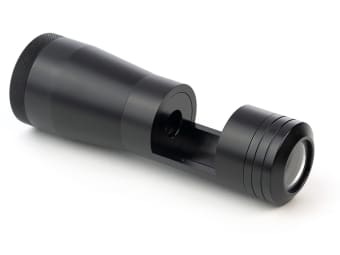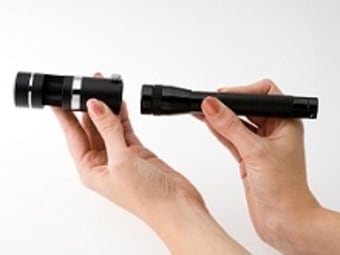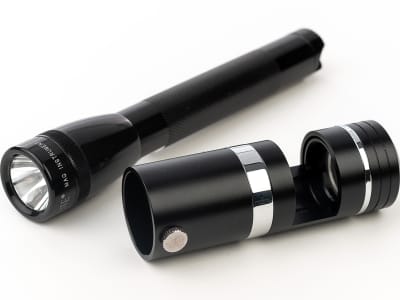The Darkfield Loupe
Overview:
This simple piece of equipment is a revelation to new gemologists and yet, strangely, none of the major gemology training courses introduce it as part of the standard equipment kit. Almost every gemologist ends up seeking one out for themselves. Why is this? You will certainly never see a field gemologist without one. If there was one area of gemology that captures the purest analog of gemology, it is going to be those who make a living by examining what has just emerged from the ground in nature.
Let’s examine this amazing, affordable piece of equipment and include steps for honing your technique with one.
What is a darkfield loupe?
First, let’s look at the darkfield loupe and why it is so useful.
At first glance, it is a 10x lens at the end of a tube that will screw onto your flashlight. Under the lens, it has an open area, a ‘viewing well’, and below that there is a cone that prevents the torchlight from shining directly up and blinding the viewer. When the torch is on, the view into the loupe shows no indication of any light being on at all. Instead, the light has been directed laterally so that it has a focal point inside this viewing well.
It is only when something is placed in the viewing well that one
can see the light hitting it. With this strong lateral lighting, it is
much easier to identify inclusions in gemstones because they are being
highlighted against a dark background, hence the darkfield loupe’s
utility in the field. This is the magic of the darkfield loupe. In a
convenient hand-held device, we have all the usefulness of a
microscope’s darkfield functionality, but in a portable format.
How to set up a darkfield loupe
Typically, a darkfield loupe is sold with a torch that fits it. Occasionally they are sold without one, in which case you’ll need to ensure that the inside diameter suits the torch intended for use. This is typically one inch or 25mm.
- Ensure the torch has fresh batteries. Darkfield viewing utilizes reflected light, so the original light source needs to be strong.
- Place the darkfield loupe attachment over the torch and secure it. It may be threaded, or it may have a small screw to lock it on.
- Once secure, turn the torch on and you will see there is light visible when viewed from the side into the viewing well. From the top, it will be dark.
- It is now ready for use.

How to use a darkfield loupe
To get started using your dark-field loupe follow the steps below.
- To examine a gemstone secure it in a set of tweezers. To examine a piece of jewelry hold it by its setting.
- Place the item you want to inspect into the viewing well.
- Bring your eye to the eyepiece at the top of the instrument and view your subject.
- While looking at your stone or jewelry be sure to position the stone to best view the features or inclusions you wish to observe.
- While you may be able to see a certain feature from one position, another angle or lighting direction may reveal even more information about the stone. You must move the object so that you are observing it from every possible angle.
- For example, as with a standard loupe, examine the stone or jewelry from the top, from the back and the sides through the girdle.
- When examining through the girdle, be sure to rotate the stone a full 360°, or if not round, view it from every side.
- As you examine from all angles, be sure to tilt and rock the stone keeping it well-lit.
- At this point, you should be very aware, particularly when viewing jewelry, of dirt or fingerprints that are interfering with your examination. Clean the object and try again.

How to interpret the results of a darkfield loupe test
Interpreting what you see:
The dark-field loupe is very useful in terms of examining inclusions in colored stones. Viewing the inclusion against a black background provided by the dark-field attachment, with strong lateral lighting, makes it much easier to examine inclusions, and it more easily distinguishes what they are. You will find it especially useful in seeing curved striae in synthetic sapphires and rubies, and in spotting the features of flux-filling, lead-glass color flashes.
Further suggestions:
As important as the dark-field loupe can be when examining colored
gemstones, it is also an essential tool for anyone buying and selling
diamonds or diamond jewelry; this is because there are many
fractured-filled diamonds in circulation worldwide. So in addition to
helping identify clarity treatments in diamonds, the darkfield loupe
can also help in determining if a diamond is mined or lab-grown. This
is done by searching for girdle markings or sub-surface etched
identifiers as well as examining inclusions to decide if they are the
result of the synthetic growing process or if they are natural.
When examining jewelry, it can be very helpful in identifying
where plating is starting to wear off, exposing the underlying alloy
and letting you know something is a plated alloy rather than solid
gold or silver. Finally, the most important use of a darkfield loupe
(from an appraiser’s point of view) is helping identify hallmarks that
have been worn down to the point of obscurity. This avoids having to
use a microscope and trying a combination of light sources to tease
out the outlines of a worn hallmark or maker’s mark.

